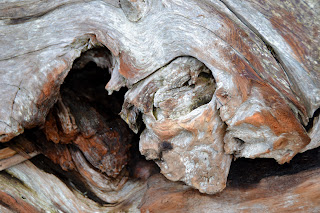I’ve had a love of the ocean and shorelines for most of my life. The tidepools brimming with life, seaweeds washed ashore, and piles of driftwood to climb and explore. So when I saw a class offered several years ago on “Driftwood Art”, I was intrigued and wanted to try it, not even knowing what it was. I suppose I imagined that I would make pieces of driftwood sticks into finished wood that I would hand my quilts off of. Was I ever wrong!
I finally got started in my first class last spring. It’s an ongoing class; many of the students have been doing it for year. The Northwest Driftwood Artists are the group behind the classes which I take. They have a specific method (the Luron Method) of taking driftwood pieces and bringing out the inner beauty of the wood, rather than carving or changing the wood’s nature.
 The process is rather painstaking. You clean and scrape the piece of driftwood, removing all the dead outer wood, until you get to the rich inner heartwood and can see the wood’s grain. Next, you sand (and sand, and sand) the piece. Finally, you rub the finalized sculpture with a beeswax-turpentine mixture to bring out the color. Sound easy? I’m still working on my first piece after about 10 months! Maybe I’m a slow learner….
The process is rather painstaking. You clean and scrape the piece of driftwood, removing all the dead outer wood, until you get to the rich inner heartwood and can see the wood’s grain. Next, you sand (and sand, and sand) the piece. Finally, you rub the finalized sculpture with a beeswax-turpentine mixture to bring out the color. Sound easy? I’m still working on my first piece after about 10 months! Maybe I’m a slow learner….
 What I am good at is finding some incredible pieces of driftwood. I probably have enough pieces now to last the rest of my life, at least at the rate I’m going now.
What I am good at is finding some incredible pieces of driftwood. I probably have enough pieces now to last the rest of my life, at least at the rate I’m going now.
While the photos here are of beautiful raw driftwood (much of it too large to get home to my studio), the exemplify what is looked for in making driftwood sculpture: an interesting pattern and grain of the wood, and hopefully some luscious coloring .
 To see some of the fabulous completed pieces, go to the Northwest Driftwood Artists website. I hope to have my first piece completed in time for the annual show in May.
To see some of the fabulous completed pieces, go to the Northwest Driftwood Artists website. I hope to have my first piece completed in time for the annual show in May.

You might also be interested in:
Sunshine and Sand
Golden Hour at Penn Cove
Skagit Skies

